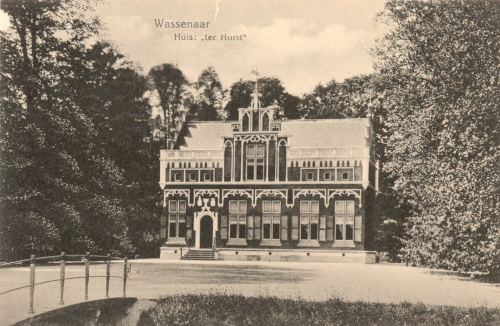The style of Prince Frederick
Do you like it when your interior is one? Prince Frederik of the Netherlands used to do that wholesale. Bridges, service houses, retaining walls, farms, his own country houses: many architectural elements on his nine estates in Wassenaar were given the same look. This was beautiful and everyone could see at a glance that they were on Prince Frederik's property.
De Paauw was the first country house in Wassenaar purchased by Prince Frederik. He made this purchase in the spring of 1838, and he was very anxious to get to know his new home and park outside the city. In August he celebrated there the birthday party of his father, King William I. This does not sound surprising, but it was, because the previous owner's furniture was still there! This furniture was not offered for sale until December of that year; so all this time the prince was living with other people's belongings around him.
Expansionist
After De Paauw, Prince Frederik successively bought eight more estates through 1854: Raaphorst, Ter Horst, Eikenhorst, Backershagen and Groot Haesebroek, including Drie Papegaaien, Wildrust and Het Zwarte Hek. His territory thus ran from the Veurseweg in Voorschoten to the dunes and was as large as 886 hectares. The prince wanted to beautify the diversity of buildings and natural beauty and merge them into one whole. To this end, many buildings from different times were modernized into one style.
Court Architect Wentzel
For the built parts, Prince Frederick brought German architect Hermann Wentzel to the Netherlands in 1851. The prince knew him from the Prussian court in Berlin, the place where he himself had grown up. For twenty years, Wentzel was his court architect. He began by enlarging and embellishing De Paauw into a Prussian palace. Last, he worked on renovating Ter Horst. He created unity by adapting existing elements and building new bridges and service houses in always the same style.
The chalet style
Wentzel applied the chalet style, a romantic architectural style that was very popular in the nineteenth century. Indeed, at that time people were very charmed by the "unspoiled" chalets in the mountain regions of, for example, Switzerland. The style was characterized by overhanging roofs and lavishly decorated carvings on eaves and gables. The decorations had a pattern of openings, much like lace has. This is also called ajour or lacework. He often combined the chalet style with other architectural styles to create an eclectic whole.
The retaining wall
When Prince Frederik bought the Backershagen estate, there was already a beautiful tea dome on a high, artificial hill. This was on the route along which the carriage went when the prince drove from Eikenhorst via Backershagen to De Paauw. But the hill was in danger of subsiding. Therefore he had a retaining wall constructed by Hermann Wentzel. The wall was elegantly finished by a brick railing with ajour work.
Feel free to walk to the retaining wall: then you can admire this beautiful mesh work up close. And you will have a view of another special object: the hertimage, the cave of a hermit located on a peninsula. Such follies' were part of a landscaped park layout, where the walker was surprised each time by exciting elements. Today, the teahouse is privately occupied.
The shooting house
Prince Frederick was fond of hunting and had a beautiful shooting house on De Horsten. It is a picturesque, octagonal building, on the thatched roof proudly displayed a pheasant. Attached to the building was a glass gallery. At 100 meters from it was a rail, over which a fake hare or pheasant slid. From the shooting house, Prince Frederick and his guests could shoot at the moving target for practice and entertainment. Today, the shooting house is a tea pavilion: while enjoying a drink, you can admire its rich history. On the wall you can still admire hunting trophies and deer antlers.
Ter Horst
As mentioned, Prince Frederick was an enthusiastic hunter and therefore had the dilapidated Huis ter Horst rebuilt into a small hunting lodge in neo-Gothic style. Architect P.F.W.. Mouton was commissioned for this purpose. After an exhausting hunt, the prince and his party would settle here to recover from their exertions and enjoy a sumptuous meal. The facade has a stepped gable slightly off-center and decorations above the doors and windows. Incidentally, he did not enjoy it for long; the house was completed in 1876 and Prince Frederik died in 1881.
Around the entire hunting area were two-meter high pillars with the inscription: 'Own hunt of HRH Prince Frederik'. It could only be clear!

Find out for yourself!
The Parks Trail has many built elements that are all gems. Therefore, the examples above are just a tip of the iceberg. Go out and admire the bridges, service houses, boundary posts, mansions and whatnot all by yourself!